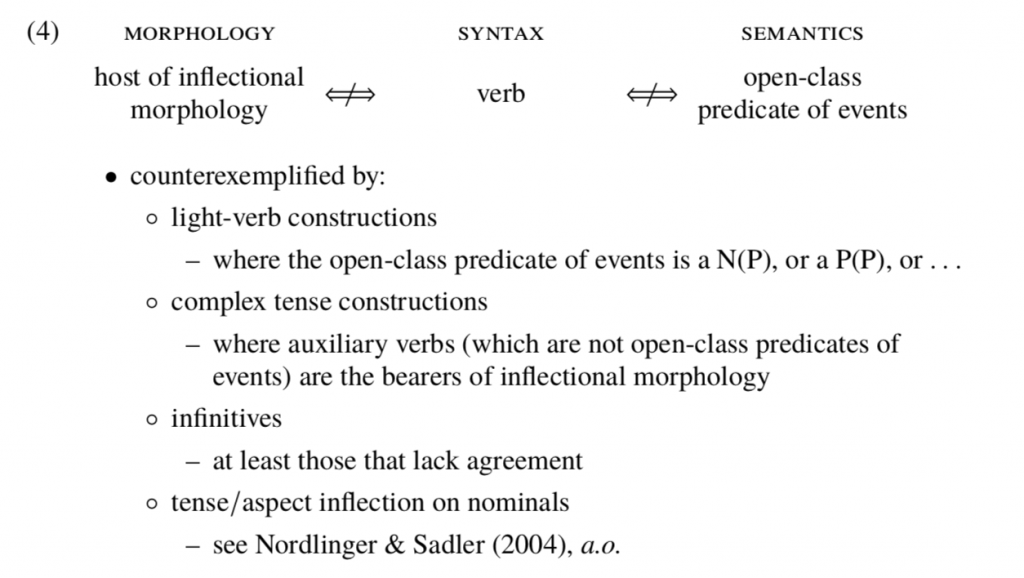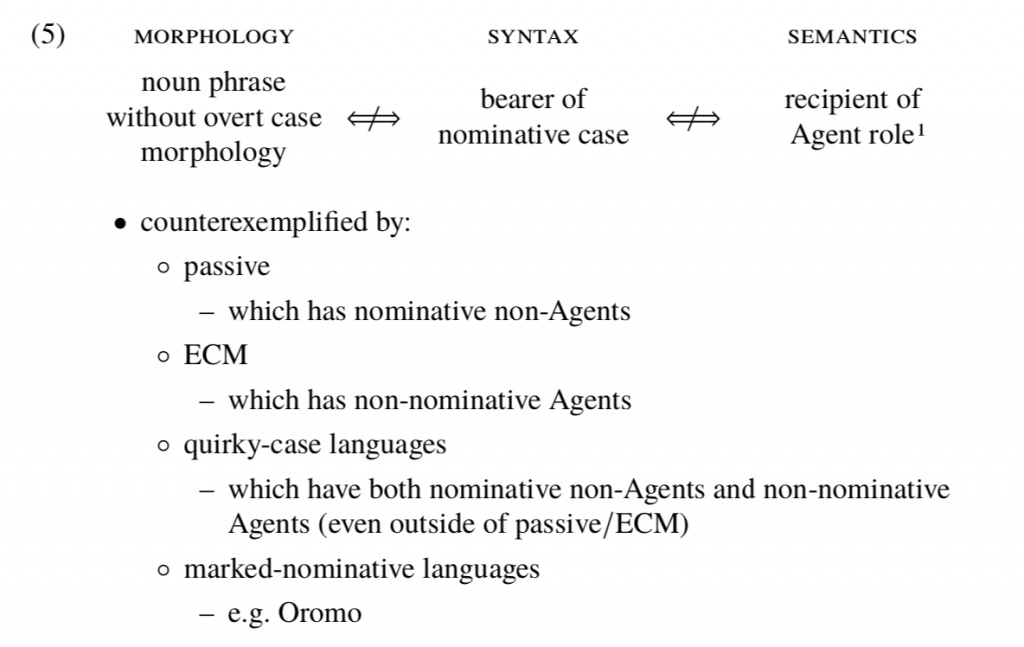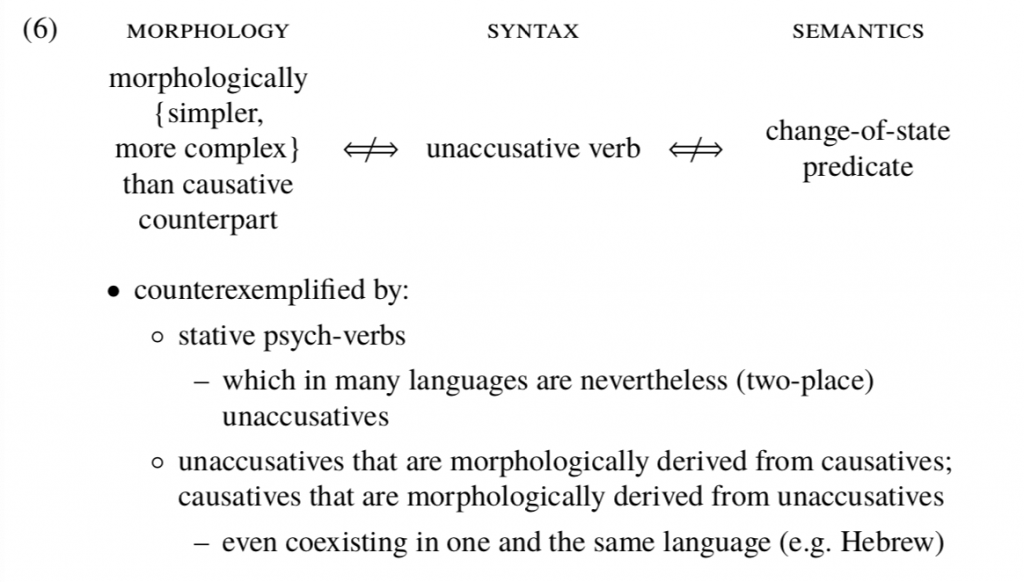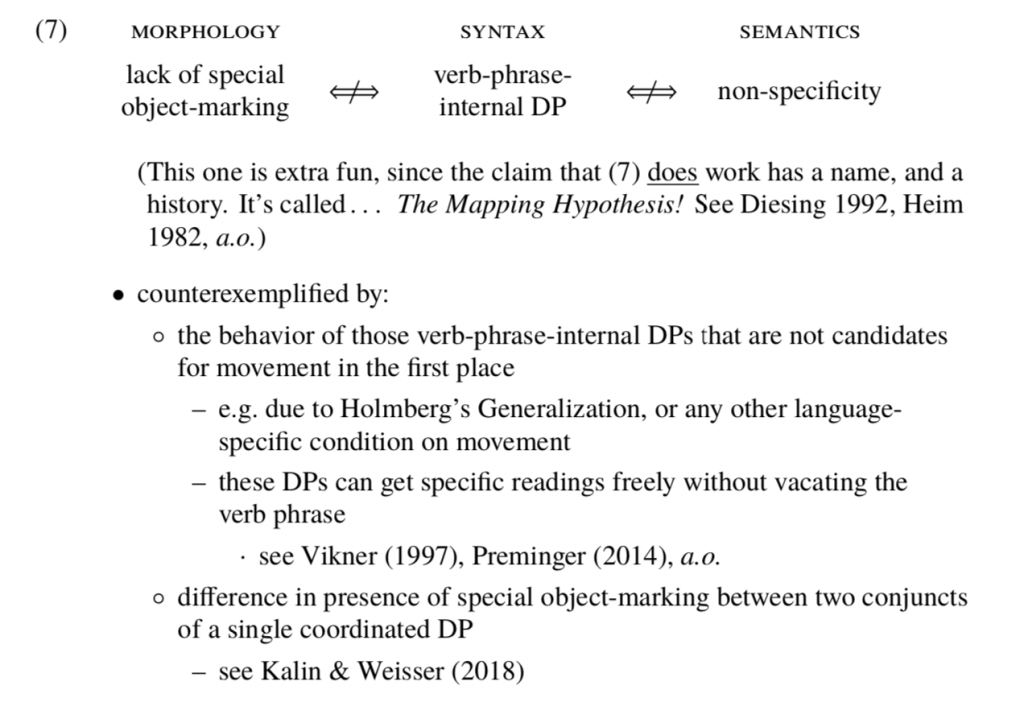There’s been a fair amount of generative linguistics work over the past 15 years or so that identifies itself as “morphosemantics.” There are several reasons why I don’t think morphosemantics is a coherent notion. In this post, I’d like to detail some of these reasons. You’ve probably heard ~1.5 of them before, though, so if that’s the case feel free to skip ahead as needed.
The first reason is conceptual. As already discussed on this blog, there is – definitionally – no direct “line of communication” between morphology and semantics. Syntactic structure is ‘interpreted'(=morphologized) by the morphological component, and syntactic structure is ‘interpreted'(=interpreted) by the semantic component. But the grain-size of the former mapping (syntax→morphology) doesn’t even align, in the general case, with the grain-size of the latter mapping (syntax→semantics). In other words, morphemes don’t have interpretations, and meanings don’t have a spellout. (Well, maybe some morphemes have meanings, and some meanings have spellouts; but it’s not generally true.) Talking about morphosemantics is therefore tantamount to syntax denialism. There is no “morphosemantics”; only morphosyntaxsemantics.
The second reason is empirical. In the one domain I know something about – phi‑features – it is manifestly the case that syntax involves a different representation & computation than morphology and semantics do.
The third reason, though it might be less decisive than the previous two, is potentially more interesting (and may find traction with a slightly broader audience). It basically amounts to this: I struggle to think of many empirical domains where the fundamental entities of morphology line up with the fundamental entities of syntax which line up with the fundamental entities of semantics. (Or, if you prefer, you can run this all in the other direction.) In a recent talk in Tromsø, at the much-blogged-about Thirty Million Theories of Features workshop, I recycled some observations that I originally collected for a talk at the Brussels Conference on Generative Linguistics (BCGL) in late 2017. These observations involve cases where semantics lines up imperfectly with syntax, which lines up imperfectly with morphology. They are, by and large, very familiar and mundane cases. But maybe that’s the point: people have gotten so used to the existence of these cases that they no longer internalize what these cases can teach us. Here’s the first one:

Another way to phrase what (4) is saying: there is neither a necessary nor a sufficient morphological condition for ‘verbhood’, nor is there a necessary or a sufficient semantic condition for ‘verbhood’. And this is fine! No one takes this as evidence that there is no such thing as a ‘verb’, or as some colossal failure of the theories of syntax and/or morphology and/or semantics. This is exactly what you’d expect, in fact, if the three were different modules.
And that’s the real lesson here. Of course there are significant portions of the relevant mappings that are systematic – what else would you expect from a system that, at the end of the day, is learnable and learned? – but the idea that reliable mappings are intrinsic to the very nature of the system is plainly false.
There’s plenty more where that came from, of course:

(The content of the footnote on ‘Agent role’ is: “It is likely that there is a syntactic correlate of Agenthood, of course (e.g. base-generation in [Spec,vP]). But tellingly: the latter, syntactic property has no consistent morphological correlate – not even in ergative languages (see Baker & Bobaljik 2017 for a recent review).”)
And more:

And more:

As I said in the handout from which these snippets are taken: the mapping between morphology, syntax, and semantics is certainly not random. If nothing else, the system in its entirety has to be learnable, after all. But the claim that it is a reliable, transparent mapping is clearly false. It amounts to taking what is a worthwhile methodological heuristic and elevating it, artificially and incorrectly, to the status of grammatical principle. That would be like seeing Newtonian physics and concluding, “Oh, gosh, I guess all objects really are points in a frictionless vacuum!”
The consequences of all this for the notion of “morphosemantics” should be clear: if the mapping from morphology to syntax to semantics is not a reliable, transparent mapping in the first place, there can be no “morphosemantics.” There’s the (imperfect) mapping of particular syntactic structures to morphology; and there is the (imperfect) mapping of potentially overlapping (but seldom identical) syntactic structures to semantics. Could you imagine anyone talking about the “morphosemantics” of open-class event predication? Well I don’t think there’s any reason to believe that other empirical domains would be any different. And judging by the state of affairs with respect to phi‑features (see above), that doubt seems justified.